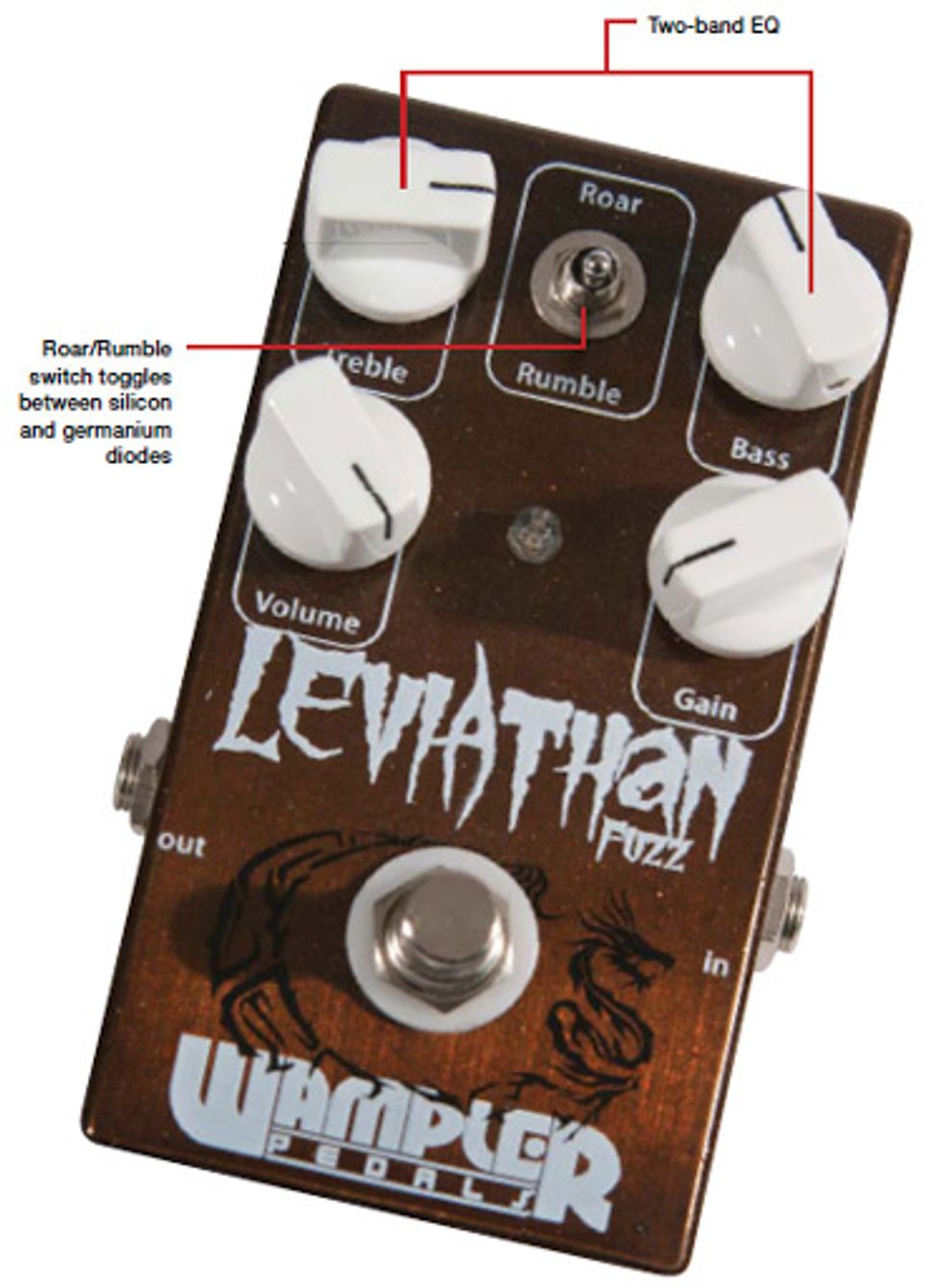 Listen: |
Wampler’s way to a more unique fuzz took a more aggressive route, one inspired by the sounds of players like the Smashing Pumpkin’s Billy Corgan. In taking that path, Wampler created a fuzz worthy of its namesake—a demon prince of tone rising from the depths, wholly intent on obliterating everything within earshot.
A Demon Rises
Wampler touts the Leviathan’s circuit as completely unique and not derived from any fuzz pedal in particular. Instead, the company used the sounds of a few specific players as ideals. Corgan’s tone on the Pumpkins’ 1994 landmark album, Siamese Dream, was a major influence, and as some modern metal fans might guess, the ripping sounds of stoner-rock darlings Mastodon were also inspirational.
The Leviathan’s control layout is fairly conventional, though it might seem busy to fans of old two- and three-knob fuzzes. A simple 2-band EQ—Treble and Bass— shape the low- and high-end content, while Volume and Gain knobs control level and fuzz content. The clipping mode can be switched between germanium or silicon diodes via the Roar/Rumble switch—effectively flipping between wider and more compressed fuzz tones.
Though most gigging guitarists these days have ditched batteries in favor of multi-outlet power supplies, it’s still a hassle to unscrew the back panel to replace the battery. It wasn’t a huge deal with the Leviathan, as I didn’t need to change the battery after playing it for several hours, but having a simple battery door would have been a nice convenience.
It Came from the Deep
The tones that lie in wait within the Leviathan are not subtle. In fact, this has to be one of the most raging, over-the-top fuzz pedals I’ve come across in quite some time. Using a Stratocaster routed through the Leviathan and into a Bogner Barcelona 40-watt combo, I set all of the controls straight up, flipped the clipping switch to Roar (germanium-diode mode), and dug into some early-’90s Seattle-inspired riffage. The sound was burly and very aggressive, with great top-end bite and a pummeling, grinding midrange. Backing off of the Strat’s volume knob coaxed some detail back into the tone but sacrificed high-end bite—nothing a small adjustment of the Treble knob couldn’t fix.
It was simple to get a super-aggressive fuzz, too, but the pedal can get a little muddy if you don’t take the time to set things up right. Some of the sweet spots for lead playing aren’t as effective for rhythm work, either (though this is not uncommon for aggressive fuzz units). Extreme Treble and Bass settings yielded hairy, unruly tones perfect for modern stoner rock. If that type of music is your bag, then the Leviathan is an absolutely perfect choice.
Avoiding tones that don’t sound like your speaker is imploding requires conservative use of the Gain control. But just a little gain goes a long way and can really add some muscle to your amp. Even with the Strat’s relatively low-output pickups, I dialed in a very thick, ’90s-grunge rhythm tone with the Treble at 11 o’clock, Bass at 1 o’clock, Gain at 1 o’clock, and the Barcelona’s master volume at almost 3 o’clock. The tone was fat and defined, and single notes sustained with a sweet, singing quality.
Moving the clipping switch to the Rumble (silicon diode) position boosted the gain significantly, but it also lowered the volume significantly. In order to get the fuzz at unity gain with the bypassed tone, I had to crank the Volume knob up to the 3 o’clock position.
Blood and Thunder
Humbuckers are a great match for the Leviathan, too, provided the pedal’s Gain control isn’t turned up too high. My Les Paul gave the pedal an entirely new voice. Fuzz pedals that can preserve the guitar’s natural tone aren’t commonplace—especially those that have as much gain on tap as the Leviathan does—but in this instance the Les Paul’s heft came through loud and clear, with a massive amount of low end. Staying conservative with the Gain control and finding a sweet spot with the Treble and Bass knobs was key to obtaining a great tone that remained present with a band mix but that also retained the expansively hairy tendencies the Leviathan was designed for. Still, I found that the pedal seemed to sit better with single-coil pickups—their low output and bell-like attack seemed to bring out the most pleasing frequencies.
The Verdict
If you’re looking for a fuzz pedal that lives at the more extreme and pummeling end of the fuzz spectrum, the Wampler Leviathan is up to the task. It’s a force to be reckoned with, but that power rarely comes at the expense of your guitar’s natural tone. It’s capable of subtler fuzz tones, but it excels at super heaviness—and it will kick out the biggest, burliest fuzz tone you can get from a stompbox. This is a pedal truly deserving of its name.
Buy if...
only the most aggressive and ballsy fuzz tone will do.
Skip if...
you require smoother, more refined fuzz suitable for classic-rock type tones.
Rating...
Street $199 - Wampler Pedals - wamplerpedals.com |







![Rig Rundown: Russian Circles’ Mike Sullivan [2025]](https://www.premierguitar.com/media-library/youtube.jpg?id=62303631&width=1245&height=700&quality=70&coordinates=0%2C0%2C0%2C0)

























